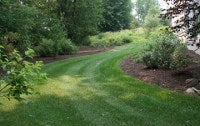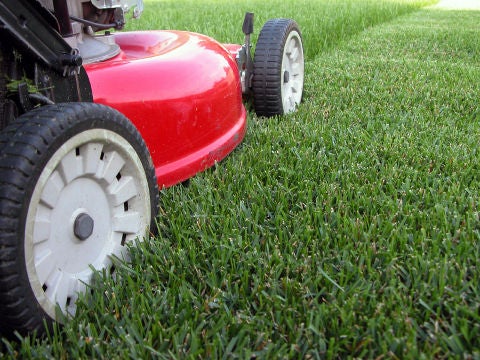
Many of us enjoy lawns for a variety of reasons – kicking the ball with our children, sitting with friends, as paths between beds or as a smooth green contrast to our textured and colourful garden beds. There are several things you can do to maintain your lawn in an earth-friendly way.
First, look at how much lawn you have and how much you actually need. See if you can replace any areas with lush vibrant habitat or an area that would not require as much maintenance. While keeping some grass can be useful and enjoyable, reduced lawn maintenance can save time, money and reduce pollution. Some people have replaced part or all their lawns with a meadow look, while others have made rock gardens or formal gardens with stone pathways. See what balance is best for you and your family. Visit our Recreating Natural Habitats, Design and Planning, and Certified Gardens sections for ideas that might suit you and our Native Plant Encyclopedia for plants that are suitable for your area, the conditions of your garden and any xeriscaping needs.
If you do keep some lawn, see if you can avoid watering it. We are seeing more and more municipalities prohibiting or limiting watering lawns in response to water shortages due to dry weather, polluted water or simply the long task of replacing water pipes. Grass typically goes dormant in dry weather, returning to green once the rains return. Help your grass survive these times by amending the soil with compost to retain moisture, letting grass grow a bit higher and overseeding to keep the lawn dense enough to provide shade for the soil which helps keep roots healthy and retains moisture.
If you do choose to water your lawn, supplement rain fall when it doesn't seem sufficient, deeply yet infrequently to promote deep roots.
Another way to care for your grass the green way is to grasscycle. It is simple to do and it doesn’t require any special equipment. After mowing the lawn, leave grass clippings where they lie to decompose. Grass clippings are broken down quickly by soil organisms, providing free nutrients to your lawn. You’ll save time you would have spent gathering clippings and reduce waste simultaneously. Instead of being hauled away in a garbage bag, your yard will benefit from this easy fertilizer.
The clippings are hardly noticeable and will disappear after a couple of days. Thatch from clippings is usually a problem only if your soil is very low in microbial activity or you’ve just cut extremely long grass. If you do get large clumps, mow again to break them up. If you need to encourage more soil organisms, avoid pesticides — both chemical and organic — and chemical fertilizers. Instead, apply good rich compost to the earth to increase their numbers quickly.
Tips for successful grasscycling:
• Cut your grass every five days or so
• Keep your mower blade sharp and at a height around 7 cm
• Try not to cut more than 2.5 cm of the grass blade at a time
• Avoid mowing when the grass is wet
• Avoid mowing during a period of drought
If you don’t want to keep your clippings on your lawn, rake them up and put them on your compost pile or use as mulch in your garden beds.
- 0

